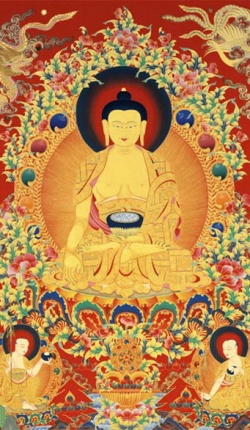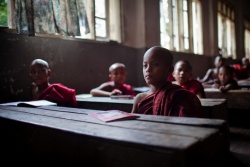Difference between revisions of "Sabhiya Kaccāna"
| Line 5: | Line 5: | ||
1. [[Sabhiya]] ([[Sambhiya]]). The [[constant]] attendant of [[Phussa Buddha]]. J.i.41; Bu.xix.19. | 1. [[Sabhiya]] ([[Sambhiya]]). The [[constant]] attendant of [[Phussa Buddha]]. J.i.41; Bu.xix.19. | ||
| − | 2. [[Sabhiya]] [[Thera]]. His mother was a nobleman's daughter whose [[parents]] had committed her to the charge of a [[Paribbājaka]], that she might learn various [[doctrines]] and usages. The [[Paribbājaka]] seduced her, and, when she was with child, the fraternity abandoned her. Her child was born in the open (sabhāyam), while she was wandering about alone hence his [[name]]. When [[Sabhiya]] grew up he, in his turn, became a [[Paribbājaka]] and was famous as a {{Wiki|dialectician}}. He had a [[hermitage]] by the city gate, where he gave lessons to the sons of noblemen and others. He devised twenty questions, which he put before recluses and [[brahmins]], but none could answer them. These questions had been handed on to him by his mother who had developed [[insight]] and had been [[reborn]] in a [[Brahma world]]. (But see [[Sabhiya Sutta]] 1). Then, as related in the [[Sabhiya Sutta]] 1, [[Sabhiya]] visited the [[Buddha]] in [[Veluvana]] and, at the end of the [[discussion]], entered the Order, where, developing [[insight]], he won [[arahantship]]. | + | 2. [[Sabhiya]] [[Thera]]. His mother was a nobleman's daughter whose [[parents]] had committed her to the charge of a [[Paribbājaka]], that she might learn various [[doctrines]] and usages. The [[Paribbājaka]] seduced her, and, when she was with child, the [[fraternity]] abandoned her. Her child was born in the open (sabhāyam), while she was wandering about alone hence his [[name]]. When [[Sabhiya]] grew up he, in his turn, became a [[Paribbājaka]] and was famous as a {{Wiki|dialectician}}. He had a [[hermitage]] by the city gate, where he gave lessons to the sons of noblemen and others. He devised twenty questions, which he put before recluses and [[brahmins]], but none could answer them. These questions had been handed on to him by his mother who had developed [[insight]] and had been [[reborn]] in a [[Brahma world]]. (But see [[Sabhiya Sutta]] 1). Then, as related in the [[Sabhiya Sutta]] 1, [[Sabhiya]] visited the [[Buddha]] in [[Veluvana]] and, at the end of the [[discussion]], entered the Order, where, developing [[insight]], he won [[arahantship]]. |
In the [[time]] of [[Kakusandha Buddha]] he was a [[householder]] and gave the [[Buddha]] a pair of sandals. After [[Kassapa]] [[Buddha's]] [[death]] he, with six others, joined the Order and lived in the {{Wiki|forest}}. Failing to develop [[jhāna]], they went to the top of a mountain, determined to reach some [[attainment]] or to [[die]] of starvation. The eldest became an [[arahant]], the next became an [[anāgāmī]] and was [[reborn]] in the Suddhāvasā. The remaining five [[died]] without achieving their aim. These five were, in this age, [[Pukkusāti]], [[Sabhiya]], [[Bāhiya]], Kumārakassapa and Dabbamallaputta. ThagA.i.381f.; SNA.ii.419ff.; Ap.ii.473; DhA.ii.212. | In the [[time]] of [[Kakusandha Buddha]] he was a [[householder]] and gave the [[Buddha]] a pair of sandals. After [[Kassapa]] [[Buddha's]] [[death]] he, with six others, joined the Order and lived in the {{Wiki|forest}}. Failing to develop [[jhāna]], they went to the top of a mountain, determined to reach some [[attainment]] or to [[die]] of starvation. The eldest became an [[arahant]], the next became an [[anāgāmī]] and was [[reborn]] in the Suddhāvasā. The remaining five [[died]] without achieving their aim. These five were, in this age, [[Pukkusāti]], [[Sabhiya]], [[Bāhiya]], Kumārakassapa and Dabbamallaputta. ThagA.i.381f.; SNA.ii.419ff.; Ap.ii.473; DhA.ii.212. | ||
| Line 17: | Line 17: | ||
1. [[Sabhiya Sutta]]. The sixth [[sutta]] of the [[Mahāvagga]] of the [[Sutta Nipāta]] (SN., pp. 91f). A [[devatā]], who in a previous [[life]] had been a [[relation]] of [[Sabhiya]] (see [[Sabhiya]] 1), asks him a series of questions and exhorts him to join the Order of any [[recluse]] who can answer them satisfactorily. [[Sabhiya]] wanders about asking his questions of several well known [[teachers]]; failing to find [[satisfaction]], he visits the [[Buddha]] in [[Veluvana]] at [[Rājagaha]] and is given permission to ask anything he wishes, the [[Buddha]] [[promising]] to solve his difficulties. Then follows a series of questions answered by the [[Buddha]]. [[Sabhiya]], in the end, asks permission to join the [[Buddha's]] Order. This permission is given, and after the usual probationary period of four months, he becomes an [[arahant]]. | 1. [[Sabhiya Sutta]]. The sixth [[sutta]] of the [[Mahāvagga]] of the [[Sutta Nipāta]] (SN., pp. 91f). A [[devatā]], who in a previous [[life]] had been a [[relation]] of [[Sabhiya]] (see [[Sabhiya]] 1), asks him a series of questions and exhorts him to join the Order of any [[recluse]] who can answer them satisfactorily. [[Sabhiya]] wanders about asking his questions of several well known [[teachers]]; failing to find [[satisfaction]], he visits the [[Buddha]] in [[Veluvana]] at [[Rājagaha]] and is given permission to ask anything he wishes, the [[Buddha]] [[promising]] to solve his difficulties. Then follows a series of questions answered by the [[Buddha]]. [[Sabhiya]], in the end, asks permission to join the [[Buddha's]] Order. This permission is given, and after the usual probationary period of four months, he becomes an [[arahant]]. | ||
| − | According to the [[Theragāthā]] Commentary (ThagA.i.382), quoted also in the [[Sutta Nipāta]] Commentary, the questions were formulated by Sabhiya's mother, who, [[feeling]] revulsion for her womanhood, developed the [[jhānas]] and was [[reborn]] in a [[Brahma world]]. But the [[Sutta Nipāta]] Commentary itself (SNA.ii.421) says that they were taught to [[Sabhiya]] by an [[anāgāmī]] [[Brahmā]], who had been a fellow [[celibate]] of [[Sabhiya]] in the [[time]] of [[Kassapa]] [[Buddha's]] dispensation. The [[Sutta]] is also called [[Sabhiya]] pucchā, and is given (E.g., DA.i.155) as an example of the [[Buddha's]] [[sabbaññupavārana]], his willingness to answer any question whatever without restriction. | + | According to the [[Theragāthā]] Commentary (ThagA.i.382), quoted also in the [[Sutta Nipāta]] Commentary, the questions were formulated by Sabhiya's mother, who, [[feeling]] revulsion for her womanhood, developed the [[jhānas]] and was [[reborn]] in a [[Brahma world]]. But the [[Sutta Nipāta]] Commentary itself (SNA.ii.421) says that they were [[taught]] to [[Sabhiya]] by an [[anāgāmī]] [[Brahmā]], who had been a fellow [[celibate]] of [[Sabhiya]] in the [[time]] of [[Kassapa]] [[Buddha's]] dispensation. The [[Sutta]] is also called [[Sabhiya]] [[pucchā]], and is given (E.g., DA.i.155) as an example of the [[Buddha's]] [[sabbaññupavārana]], his willingness to answer any question whatever without restriction. |
It is said (ThagA.i.427) that Yasadatta, Sabhiya's companion, was {{Wiki|present}} at the [[discussion]] with the [[Buddha]] and listened eagerly hoping for a chance of [[criticism]]. But the [[Buddha]] read his [[thoughts]] and admonished him at the end of the [[sutta]]. | It is said (ThagA.i.427) that Yasadatta, Sabhiya's companion, was {{Wiki|present}} at the [[discussion]] with the [[Buddha]] and listened eagerly hoping for a chance of [[criticism]]. But the [[Buddha]] read his [[thoughts]] and admonished him at the end of the [[sutta]]. | ||
Latest revision as of 09:17, 23 February 2015
1. Sabhiya (Sambhiya). The constant attendant of Phussa Buddha. J.i.41; Bu.xix.19.
2. Sabhiya Thera. His mother was a nobleman's daughter whose parents had committed her to the charge of a Paribbājaka, that she might learn various doctrines and usages. The Paribbājaka seduced her, and, when she was with child, the fraternity abandoned her. Her child was born in the open (sabhāyam), while she was wandering about alone hence his name. When Sabhiya grew up he, in his turn, became a Paribbājaka and was famous as a dialectician. He had a hermitage by the city gate, where he gave lessons to the sons of noblemen and others. He devised twenty questions, which he put before recluses and brahmins, but none could answer them. These questions had been handed on to him by his mother who had developed insight and had been reborn in a Brahma world. (But see Sabhiya Sutta 1). Then, as related in the Sabhiya Sutta 1, Sabhiya visited the Buddha in Veluvana and, at the end of the discussion, entered the Order, where, developing insight, he won arahantship.
In the time of Kakusandha Buddha he was a householder and gave the Buddha a pair of sandals. After Kassapa Buddha's death he, with six others, joined the Order and lived in the forest. Failing to develop jhāna, they went to the top of a mountain, determined to reach some attainment or to die of starvation. The eldest became an arahant, the next became an anāgāmī and was reborn in the Suddhāvasā. The remaining five died without achieving their aim. These five were, in this age, Pukkusāti, Sabhiya, Bāhiya, Kumārakassapa and Dabbamallaputta. ThagA.i.381f.; SNA.ii.419ff.; Ap.ii.473; DhA.ii.212.
Sabhiya is mentioned as an example of a pandita Paribbājaka (SA.ii.188). A series of verses spoken by him, in admonishing monks who sided with Devadatta, are given in the Theragāthā (vs. 275 8; see also Mtu.iii.389ff.).
Yasadatta (q.v.) was Sabhiya's companion.
3. Sabhiya. A Paribbājaka, perhaps identical with Sabhiya (2). The Samyutta (S.iv.401f ) records a discussion which took place at Ñātikā between him and Vacchagotta on various questions, such as the existence of the Buddha after death, etc. In this Sutta, Sabhiya is addressed as Kaccāna, and he says that he had then been three years in the Order. It is probably this same Paribbājaka who is mentioned as Abhiya Kaccāna in the Anuruddha Sutta. M.iii.148f.
1. Sabhiya Sutta. The sixth sutta of the Mahāvagga of the Sutta Nipāta (SN., pp. 91f). A devatā, who in a previous life had been a relation of Sabhiya (see Sabhiya 1), asks him a series of questions and exhorts him to join the Order of any recluse who can answer them satisfactorily. Sabhiya wanders about asking his questions of several well known teachers; failing to find satisfaction, he visits the Buddha in Veluvana at Rājagaha and is given permission to ask anything he wishes, the Buddha promising to solve his difficulties. Then follows a series of questions answered by the Buddha. Sabhiya, in the end, asks permission to join the Buddha's Order. This permission is given, and after the usual probationary period of four months, he becomes an arahant.
According to the Theragāthā Commentary (ThagA.i.382), quoted also in the Sutta Nipāta Commentary, the questions were formulated by Sabhiya's mother, who, feeling revulsion for her womanhood, developed the jhānas and was reborn in a Brahma world. But the Sutta Nipāta Commentary itself (SNA.ii.421) says that they were taught to Sabhiya by an anāgāmī Brahmā, who had been a fellow celibate of Sabhiya in the time of Kassapa Buddha's dispensation. The Sutta is also called Sabhiya pucchā, and is given (E.g., DA.i.155) as an example of the Buddha's sabbaññupavārana, his willingness to answer any question whatever without restriction.
It is said (ThagA.i.427) that Yasadatta, Sabhiya's companion, was present at the discussion with the Buddha and listened eagerly hoping for a chance of criticism. But the Buddha read his thoughts and admonished him at the end of the sutta.
The questions contained in the sutta had been asked and answered in the time of Kassapa Buddha, too, but, while the questions remained, the answers disappeared. VibhA., p. 432.
2. Sabhiya Sutta. Records the discussion between Sabhiya Kaccāna (Sabhiya 2) and Vacchagotta. S.iv.401f. </poem>

